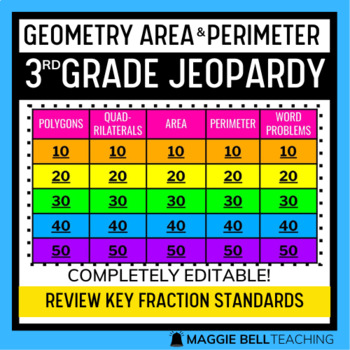Geometry, Area and Perimeter Jeopardy Review Game & Test Prep (editable)
Maggie Bell Teaching
316 Followers
Grade Levels
2nd - 4th
Subjects
Resource Type
Standards
CCSS3.OA.A.1
CCSS3.OA.A.3
CCSS3.G.A.1
CCSS3.G.A.2
Formats Included
- Google Slides™
Maggie Bell Teaching
316 Followers

Made for Google Drive™
This resource can be used by students on Google Drive or Google Classroom. To access this resource, you’ll need to allow TPT to add it to your Google Drive. See our FAQ and Privacy Policy for more information.
What educators are saying
This was the perfect review for our unit test! The students loved playing and were engaged throughout
Description
Review key geometry, area and perimeter concepts with your class!
Practice varied leveled skills in the following areas:
- polygons
- quadrilaterals
- area
- perimeter
- word problems
This can be a great game to play in the classroom or online to review important information learned throughout the year. It can also be used as an engaging way to prepare for upcoming assessments.
Total Pages
Answer Key
N/A
Teaching Duration
N/A
Report this resource to TPT
Reported resources will be reviewed by our team. Report this resource to let us know if this resource violates TPT’s content guidelines.
Standards
to see state-specific standards (only available in the US).
CCSS3.OA.A.1
Interpret products of whole numbers, e.g., interpret 5 × 7 as the total number of objects in 5 groups of 7 objects each. For example, describe a context in which a total number of objects can be expressed as 5 × 7.
CCSS3.OA.A.3
Use multiplication and division within 100 to solve word problems in situations involving equal groups, arrays, and measurement quantities, e.g., by using drawings and equations with a symbol for the unknown number to represent the problem.
CCSS3.G.A.1
Understand that shapes in different categories (e.g., rhombuses, rectangles, and others) may share attributes (e.g., having four sides), and that the shared attributes can define a larger category (e.g., quadrilaterals). Recognize rhombuses, rectangles, and squares as examples of quadrilaterals, and draw examples of quadrilaterals that do not belong to any of these subcategories.
CCSS3.G.A.2
Partition shapes into parts with equal areas. Express the area of each part as a unit fraction of the whole. For example, partition a shape into 4 parts with equal area, and describe the area of each part as 1/4 of the area of the shape.



